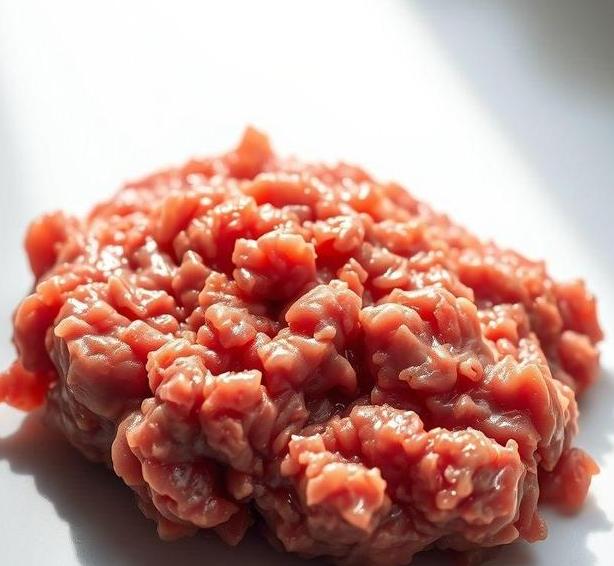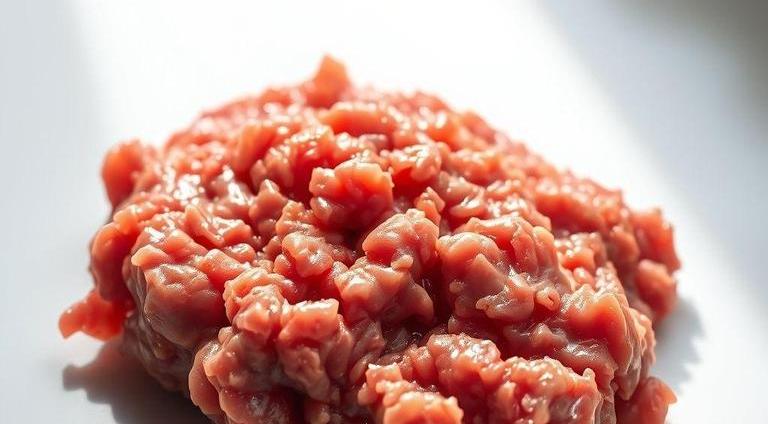Can Ground Lamb Go Bad : What You MUST Know
Ground lamb is a versatile and flavorful meat, perfect for a range of dishes like kebabs, burgers, stews, and even meatballs. Its rich taste makes it a popular choice for many culinary creations, especially in Middle Eastern, Mediterranean, and North African cuisines. But like any fresh meat, it’s important to know how to handle it properly to ensure that it stays safe to eat.
One question that often comes up is: Can ground lamb go bad? And if so, how can you tell? What’s the best way to store it? In this detailed guide, we’ll dive into all things related to the shelf life of ground lamb, how to spot spoilage, and the best storage practices to maintain its quality.
Let’s get into it!
Can Ground Lamb Go Bad?
Absolutely, ground lamb can go bad, just like any other perishable meat. Ground meats, in general, are more prone to spoilage than whole cuts because the grinding process exposes a larger surface area to bacteria and air. This means that the meat starts to degrade faster than whole cuts like lamb chops or roasts.
Several factors can influence how long ground lamb stays fresh, such as:
- Temperature: Storing lamb at incorrect temperatures can speed up spoilage. Ground lamb should always be kept in the fridge or freezer, depending on when you plan to use it.
- Exposure to air: Ground meat has a much larger surface area, which increases the potential for bacterial growth.
- Packaging: Proper packaging helps protect the meat from contamination and air exposure. If it’s poorly sealed, the chances of it spoiling increase.
Once ground lamb goes bad, it can cause foodborne illness, so it’s critical to know the signs and take the proper steps to ensure it’s safe to eat.
Shelf Life For Ground Lamb

Knowing the shelf life of ground lamb is key to understanding when it’s time to use or discard it. Here’s a general breakdown:
- In the fridge (fresh): Ground lamb can last about 1 to 2 days in the refrigerator if stored properly at a temperature of 40°F (4°C) or lower. Ideally, it should be used within this time frame for the best quality.
- In the freezer (raw): When frozen, ground lamb can last 3 to 4 months in a deep freezer without significant loss of quality. Freezing it as soon as possible after purchase is always a good idea to lock in freshness.
- Cooked ground lamb: If you’ve already cooked your ground lamb, it can be stored in the fridge for 3 to 4 days. Freezing cooked lamb can extend its shelf life to 2 to 3 months.
Always keep in mind that these are general guidelines. The shelf life can vary based on how fresh the lamb was when you bought it, how it was handled, and the conditions in your refrigerator or freezer.
Common Signs Of Spoilage
Ground lamb doesn’t usually spoil overnight, but it will eventually show clear signs that it’s no longer safe to eat. Here’s how you can spot if your ground lamb has gone bad:
Smell
- Fresh ground lamb has a distinct, slightly gamey odor. But as it spoils, the smell becomes foul, sour, or even ammonia-like. If you notice a rancid or overpowering odor, that’s a surefire sign that it’s time to toss it out.
Color
- Fresh ground lamb is typically pink to light red in color. As it starts to spoil, it will change to a dull brown or grayish hue. While a slight color change can occur naturally over time (especially if it’s been in the fridge for a while), drastic color changes are a red flag.
Texture
- Fresh lamb should be moist, but not excessively slimy. If your ground lamb feels sticky, slippery, or mushy, it’s a sign of bacterial growth. Similarly, any dry patches or excess moisture are indicators of potential spoilage.
Taste
- If you’ve cooked the lamb and it tastes sour, off, or just doesn’t taste right, it’s probably spoiled. Trust your taste buds and instincts-don’t risk eating it if something seems off.
How To Store Ground Lamb?

Storing ground lamb properly is essential to maintain its freshness and prevent early spoilage. Here are some tips for proper storage:
Refrigeration (Short-term Storage)
- Keep it cold: Store ground lamb in the coldest part of your fridge, which is usually towards the back. Make sure it stays at or below 40°F (4°C) to slow down the growth of bacteria.
- Use airtight packaging: If the lamb isn’t already in a vacuum-sealed package, consider wrapping it tightly in plastic wrap or aluminum foil, or placing it in an airtight container. This will help minimize exposure to air and moisture.
- Use quickly: As mentioned earlier, it should ideally be used within 1 to 2 days of purchase.
Freezing (Long-term Storage)
- Seal tightly: To freeze ground lamb, wrap it tightly in plastic wrap or freezer paper. For an extra layer of protection, place it in a heavy-duty freezer bag or vacuum-seal it. This prevents freezer burn and preserves the meat’s quality.
- Label & Date: Always label the packaging with the date of freezing so you can track its age. This will help you use it within the 3 to 4-month guideline.
- Don’t thaw and refreeze: Once lamb is thawed, don’t refreeze it unless it’s been cooked. This can lead to a loss of quality and increase the risk of contamination.
Leftover Cooked Lamb
- Store leftover cooked ground lamb in an airtight container in the fridge. For the best flavor and texture, consume it within 3 to 4 days. Freezing cooked lamb is also an option if you want to extend its shelf life.
Expert Tips
- Don’t buy in bulk unless you plan to freeze it: Ground lamb doesn’t last as long as whole cuts of meat, so it’s best to buy only what you plan to use in the short term unless you plan on freezing it.
- Buy fresh: Whenever possible, buy fresh ground lamb instead of pre-packaged lamb that has been sitting in the store for a while. Always check the sell-by or use-by date on the label and ensure it looks fresh when you purchase it.
- Thaw properly: If you need to thaw frozen ground lamb, it’s safest to do so in the fridge overnight. You can also use the microwave or cold water method for faster thawing, but never leave lamb at room temperature to thaw, as this can encourage bacterial growth.
- Cook soon after thawing: Once thawed, cook the ground lamb within 24 hours for the best quality and safety.
FAQs
How Long Can Ground Lamb Be Stored In The Fridge?
Ground lamb can be safely stored in the refrigerator for up to 1-2 days if kept at or below 40°F (4°C).
How Can You Tell If Ground Lamb Has Gone Bad?
Signs that ground lamb has gone bad include a sour or off smell, a change in color (becoming grayish or brown), and a slimy or sticky texture.
Can Ground Lamb Go Bad If Left Out At Room Temperature?
Yes, ground lamb can go bad quickly if left at room temperature for more than 2 hours. Bacteria multiply rapidly between 40°F (4°C) and 140°F (60°C).
Can You Freeze Ground Lamb To Extend Its Shelf Life?
Yes, ground lamb can be frozen to extend its shelf life. When properly wrapped or sealed in an airtight container, it can last for up to 3-4 months in the freezer.
What Is The Best Way To Store Ground Lamb To Prevent It From Going Bad?
Ground lamb should be stored in the coldest part of the fridge in an airtight container or wrapped tightly in plastic wrap or aluminum foil to prevent exposure to air and moisture.
Does Ground Lamb Have A Longer Shelf Life When Cooked?
Yes, cooked ground lamb can last for 3-4 days in the refrigerator, compared to raw ground lamb, which only lasts 1-2 days.
Can Ground Lamb Be Safe To Eat After The Sell-by Date?
The sell-by date is an indicator of freshness, but ground lamb can still be safe to eat after the date if properly stored. Always check for signs of spoilage, such as bad odor or discoloration, before consuming.
What Temperature Should Ground Lamb Be Cooked To Ensure It Is Safe To Eat?
Ground lamb should be cooked to an internal temperature of 160°F (71°C) to ensure it is safe to eat and all harmful bacteria are killed.
Can Ground Lamb Be Eaten After It’s Been In The Freezer For A Long Time?
Ground lamb can still be safe to eat after being in the freezer for longer than 4 months, but the quality may degrade. Freezing past this period may cause it to lose flavor and texture.
What Should I Do If I Accidentally Eat Spoiled Ground Lamb?
If you accidentally eat spoiled ground lamb, watch for symptoms of food poisoning, such as nausea, vomiting, diarrhea, or stomach cramps. Seek medical attention if symptoms are severe or persist.
